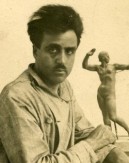 Publio Morbiducci was born in Rome on 28th August, 1889, he was the second son of Luigi, a metal worker, and Anna Maria Polizzi, who worked in a print shop. In 1900 he had to interrupt his studies for regular work as a coachbuilder, this was as a result of economic hardship falling upon his family. He continued, however, to study independently and in 1904, thanks to a brief stint in the workshop of a painter who specialised in tapestries, learned the rudiments of pictorial art, showing a distinct artistic inclination. He then attended ‘L’Instituto di Belle Arti’, where he met Duilio Cambellotti who he would always consider to be his master. In 1911 he was admitted to ‘Scuola D’Arte Della Medaglia’, where thanks to a series of grants, he studied until 1915. It was at this point that he exhibited two Roman bronze masks at ‘Secessione Romana’, it was these masks that launched his career amongst the sculptors of the time. After that he moved on to specialise in coins and medals, and in 1923 he won a competition for the design of the two-lira coin. In 1924 Ugo Ojetti presented his exhibition of medals at the American Numismatic Society in New York. In 1931, on the recommendation of Mussolini, he won the contest for the ‘Monumento al Bersagliere di Roma’, creating a figure of the popular sharpshooter. Between 1930 and 1940 he became one of the great artists of the fascist regime, and went on to be the protagonist in the exhibition to mark the tenth anniversary of the Fascist Revolution. In 1937 he was appointed a member of ‘Accademia di San Luca’. In 1939 he married Nicoletta Olga De Marchis, with whom he had his only daughter, Anna Maria (1940). From this period came the last of his monumental works: in 1939 he was commissioned to create the big marble frieze at ‘Palazzo degli Uffizi’ and in 1940, one of the groups of ‘Dioscuri’ for ‘il Palazzo della Civiltá Italiana’, whose execution was suspended for the war and completed in 1956. He died in Rome on 31st March, 1963.
Publio Morbiducci was born in Rome on 28th August, 1889, he was the second son of Luigi, a metal worker, and Anna Maria Polizzi, who worked in a print shop. In 1900 he had to interrupt his studies for regular work as a coachbuilder, this was as a result of economic hardship falling upon his family. He continued, however, to study independently and in 1904, thanks to a brief stint in the workshop of a painter who specialised in tapestries, learned the rudiments of pictorial art, showing a distinct artistic inclination. He then attended ‘L’Instituto di Belle Arti’, where he met Duilio Cambellotti who he would always consider to be his master. In 1911 he was admitted to ‘Scuola D’Arte Della Medaglia’, where thanks to a series of grants, he studied until 1915. It was at this point that he exhibited two Roman bronze masks at ‘Secessione Romana’, it was these masks that launched his career amongst the sculptors of the time. After that he moved on to specialise in coins and medals, and in 1923 he won a competition for the design of the two-lira coin. In 1924 Ugo Ojetti presented his exhibition of medals at the American Numismatic Society in New York. In 1931, on the recommendation of Mussolini, he won the contest for the ‘Monumento al Bersagliere di Roma’, creating a figure of the popular sharpshooter. Between 1930 and 1940 he became one of the great artists of the fascist regime, and went on to be the protagonist in the exhibition to mark the tenth anniversary of the Fascist Revolution. In 1937 he was appointed a member of ‘Accademia di San Luca’. In 1939 he married Nicoletta Olga De Marchis, with whom he had his only daughter, Anna Maria (1940). From this period came the last of his monumental works: in 1939 he was commissioned to create the big marble frieze at ‘Palazzo degli Uffizi’ and in 1940, one of the groups of ‘Dioscuri’ for ‘il Palazzo della Civiltá Italiana’, whose execution was suspended for the war and completed in 1956. He died in Rome on 31st March, 1963.




